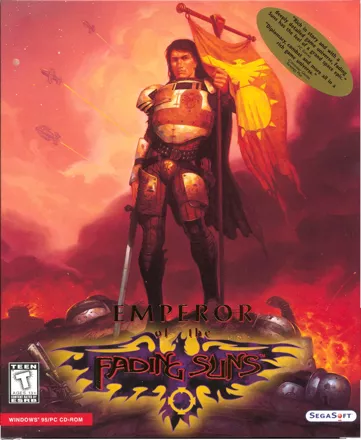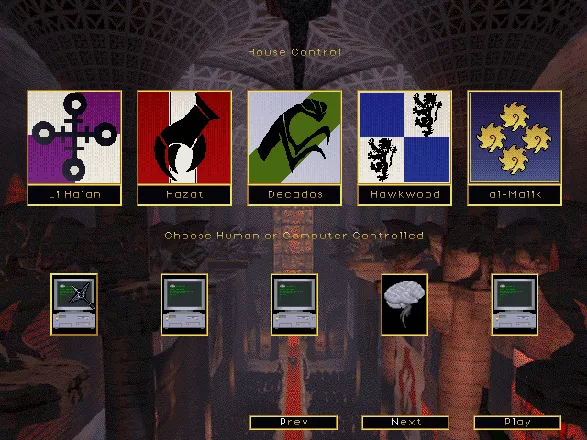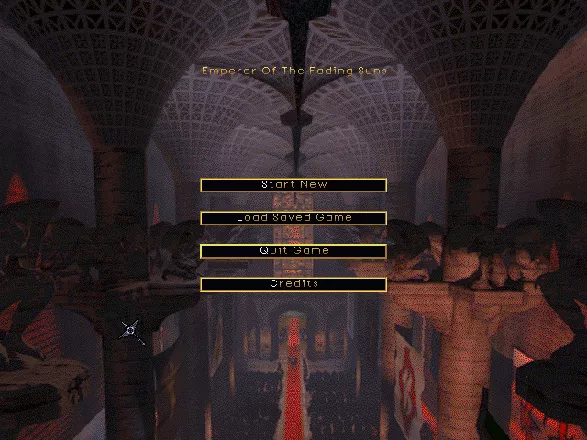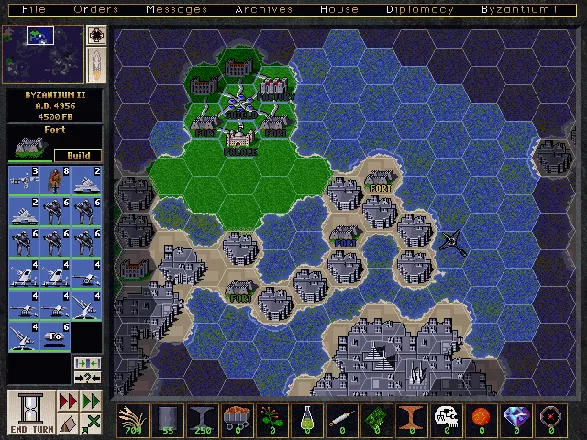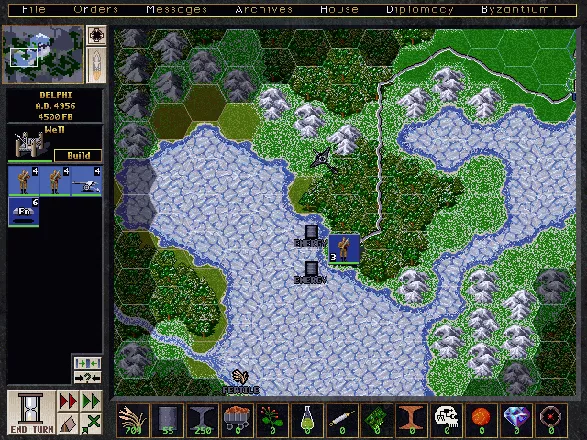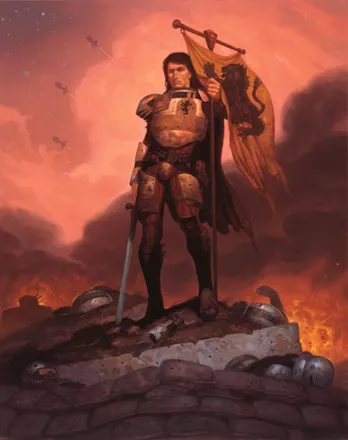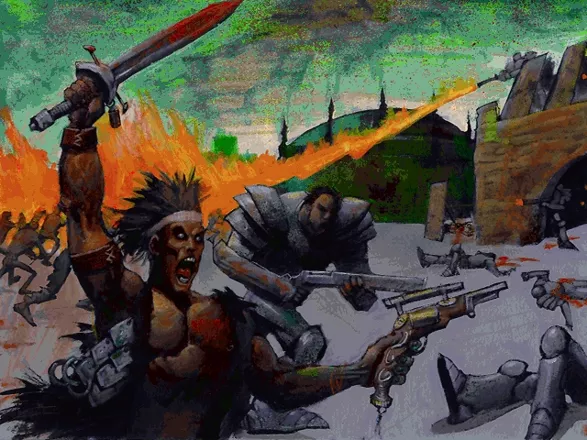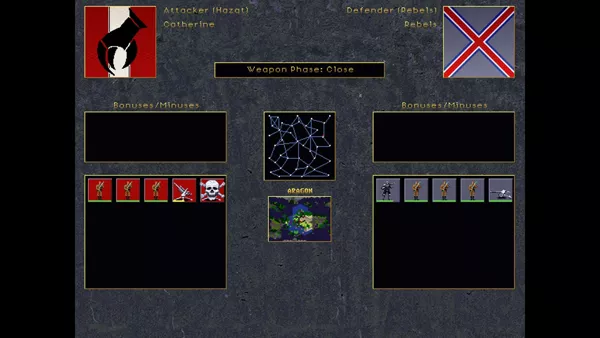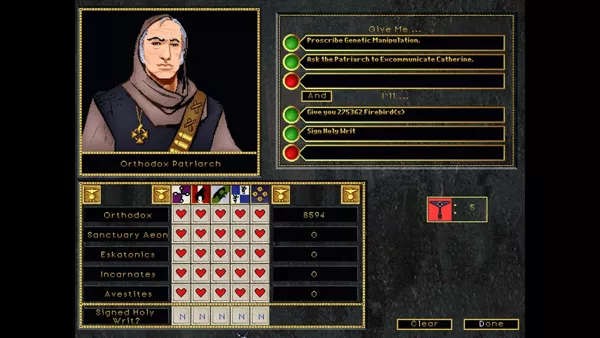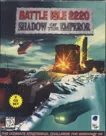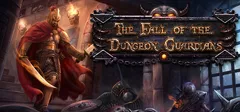Emperor of the Fading Suns
Description official description
Intriguing Civ style game from the EotFS paper RPG Universe.
Up to 5 players take the role of Houses vying for control of the known galaxy by winning political votes and siezing power.
One of many interesting game mechanics is some technolgies are "banned" by the church, and players who research it may be punished for forbidden knowledge if/when the church finds out!
Groups +
Screenshots
Promos
Credits (Windows version)
69 People · View all
| Design | |
| Lead Programming | |
| AI Programming | |
| Head of Programming | |
| Level / Scenario Design | |
| Graphics / Artwork | |
| 3D Modelling | |
| Music | |
| [ full credits ] | |
Reviews
Critics
Average score: 72% (based on 8 ratings)
Players
Average score: 3.4 out of 5 (based on 12 ratings with 3 reviews)
The Good
Emperor of the Fading Suns (here on out referred to as EOFS) for Windows is a turn based space strategy game inspired by the EOFS pen and paper universe. When I got my copy I knew nothing of the EOFS following, and examining the back of the box inclined me to take a shot at this title (I love turn based games). I expected a game that would be par for the course in this genre but instead found myself amazed at how exciting this game is to play.
The objective of the game is to become emperor, and this is accomplished by being elected to the position. Each house has a vote to cast and elections happen once every ten turns or so. Holding items called 'scepters' allows for one vote, and each house starts with 5. Scepters can be destroyed or captured, giving a house more or less than their fair share of votes.
The game starts by selecting from one of five 'houses' (nations basically) and assigning various options and difficulty levels before the game begins. Each nation has their own home planet, and each of these have specific types of environments. Therefore, playing house Hawkwood may start off a bit differently than playing house Li-Halan. You may select from a historical map (I assume the arrangement of planets here is based on the books) or you can have a randomly generated computer map.
First and foremost, the game is about resource and infrastructure building. The level of complexity for resource management is high, yet at the same time easily manageable. There are thirteen, count 'em, THIRTEEN different resources ranging from things like food and energy to biochemicals, wetware, singularities (used for jump drives on space craft) and others. Most of the resources build upon each other. For example you need chemicals to make biochemicals, which are in turn used to make another resource, and so forth. Clicking on any of your resources reveals how many units you are producing per turn, and how many you are consuming per turn. This simple and accessible interface allows the player to monitor supply and demand of these resources, thereby making adjustments to either consumption or production straight forward. Resource management seems daunting at first, but an hour or two of game time is all that is needed to become comfortable.
One thing that makes this game great is diplomacy. It's not enough to be a good military strategist, you must pick and choose your diplomatic relations. The League and the Church are other more neutral entities that can alter the path of the game. You don't want to be at war with everyone at the same time so good diplomacy skills are a must in the beginning. Diplomacy screens basically consist of "Give me..." and you can select what you want be it money, planet maps, alliances, etc. then you can propose your offer. There is a little box that says "And" which can be changed to "Or". So for example, I can say "Give me... planet map of Delphi AND I'll give you votes at the next election" On the other hand, changing the box to 'Or' changes the offer altogether. Now I can say something like "Give me Electron Microscope Technology OR I'll declare war on you". While the computer controlled opponents don't respond appropriately to most offers, in a multiplayer game this is a valuable tool.
The weapons involved is what makes this game really shine in my opinion. The type of setting combines futuristic space technology with conventional weapons of modern time. For example, I may develop the ability to create space fighters and bombers, space cargo haulers, etc. but at the same time on the ground I have tanks, anti-tank guns, fighter jets, infantry, submarines, artillery, the list goes on... each having their own movement, armor, and attack capabilities. This makes for an interesting mix of space combat and modern conventional combat strategy. You even have the option of developing biological weapons, super soldiers through combat drugs and genetic manipulation, it's up to you.
Researching technologies is quite simple but has huge impact on long term strategy. I could put a lot of time into being superior in space, or maybe I want light tanks that move fast for a quick response, or perhaps I want to be able to produce many cheap units that are strong in numbers. Added to this is that the Church outlaws certain technological research, and continues to do so throughout the game. So if I want the Xyll Warbeast as a military unit, I might have to research Symbiot Psychology which is banned by the church. If a player begins researching a banned technology, the Church will attack, usually beginning by bombarding you from space and then by sending inquisitors on the ground in an attempt to destroy your labs. This adds a whole knew dynamic in technology research strategies.
Combat is determined automatically by the computer, considering things like attack and defense bonuses, the types of units fighting each other, etc. It doesn't take hand-eye skill to win at combat, rather you must make good decisions about what to engage and how to engage it.
Resources can be moved, bought, and sold. Instead of having only a number on the screen telling you how much of a resource you have, you will actually possess somewhere in your empire a crate containing those resources. This means that they can be captured and traded. If you're being attacked, it also requires you to place your resources in a well defended place so they are not taken. Good stuff.
There really are many things going on in the game, so many angles, so many fires to put out, and so much planning that has to be done in terms of defense, resource harvesting and management, and logistics. The designers were able to create one of the most simple interfaces for a game of this scope. You are not overwhelmed with five million screens or sub menus. Information that is needed is easily attained with simple clicks on the appropriate section. If I want to see statistics for your 'House' you can click on 'House'. If I want to see how many Monopols I produce and consume, I click on 'Monopols'. Wondering which units you haven't moved yet? Just click on the green arrows to cycle through your units. EOFS is a testament that advanced and in depth game play doesn't require convoluted and confusing interfaces. Very well done.
The Bad
Every rose has its thorn, and the thorns of EOFS are very sharp and cut deep.
There are two major, and two minor drawbacks to EOFS.
The small potatoes are that the multiplay is done by either hotseat or PBEM (play by email). PBEM is horribly slow, and I've heard of games that lasted well over a year. There is a strong cult following for this game so finding PBEM players if you know where to look is not difficult, but the pace of the game is as slow as gaming gets. Hot seat isn't bad, but how often do you have a chance for that?
'Houses' don't differ in the weapons and technology they are capable of, what determines the big differences between players are not special units but the research paths they have chosen.
Now for the real problems; the game is chock full of bugs. Even with the latest patches (which by the way the official ones are very old because the company had abandoned this title long ago) there are a plethora of things that can go wrong. Lockups are frequent, mouse pointers disappear, and yes unfortunately at times saved games get corrupted for no apparent reason. This is frustrating to deal with, but the game is so much fun to play most people take this in stride.
The next serious problem with this game is the AI. The AI is absolutely terrible. For a novice player it will be a minor challenge, but anyone that knows how to play the game at even moderate levels can dominate the AI. The AI won't respond appropriately to diplomacy (i.e. rejects offers where you have overpaid them tremendously or accepts offers that rip them off) and is furthermore really good at building powerful empires that lack real defenses. For the serious player human opponents is the only way to go, and well that's slow slow slow...
There is no current official support for EOFS, but due to the large cult following players have added patches and expansions which have improved the game greatly. Doing a search for the title in google typically reveals forums and other sites dedicated to the continued advancement of this game.
The Bottom Line
EOFS is one of the best turn based strategies to date. Rich in story, atmosphere, and gameplay elements, you'd be hard pressed to find any turn based strategy as exciting as this one. If you have any strategy inklings you need to check this one out.
Note to new players; developed in 1996, EOFS will not run under winXP or win2000 unless modifications are made to the registry. You can find instruction on this online by searching or you can just download the game from http://www.the-underdogs.org/game.php?id=367 it's free and playable on modern machines.
Have fun!
Windows · by D Michael (222) · 2006
Emperor of the Fading Suns lives
The Good
Emperor of the Fading Suns still lives and continues to grow.
It has in fact been modified drastically over the last few years. The game has evolved considerably since its inception! The designers released two patches based on the suggestions of the game's players, then some of the players themselves designed patches which alter how the game plays considerably. At this point in time there are four different patches developed by the players themselves named Nova, Hyperion, Reality and most recently Subversion. There are also now two forums for players to use in order to either engage in discussions about their games or to use as a way to find players interested in playing games via E-mail. A link to these patches can be found at Fadingsun.com. I should also mention that there are also various galaxy scenarios that exist on most of these patch websites which were also developed by the players themselves such as the Rebellion Scenario for Hyperion and Nova, The Hyperion Soren Scenario and The Fulcrum Scenario for Nova and Subversion. There are quite a few others as well but a full listing would take some time.
For those who have this game on their shelf they should pull it off and give this game another hard look. There are still some bugs but all in all the few that are left are well known and easilly played around.
The game play is still turn based but the slow down wall that existed in the original game at turn 5070 has been overcome as have a great deal of the initial bugs of the game. The patches have changed the way units function on some basic levels. The Nova Patch took away movement from emplaced guns and scepters along with a mirade of other small changes. Essentially each patch plays much differently from the others. The Hyperion patch seems to have found a way to increase the activity of the Symbiots in the game to a great degree and although the computer AI is still horrible that is easilly over come by playing PBEM games against living opponents. The Subversion patch concentrates on balancing the cost of units with the resources required to build them and links their maintenance costs directly to the cost to build. This would reduce the overall amount of units one can build, however, the patch also employs a new unit known as an Economic Advisor which allows fleet sizes to be increased as the units are produced. Since the units can be captured their loss can cause an empire's economy to collapse and thereby cause fleets to no longer be maintainable. This also would tend to shorten the length of games from almost never ending to being reasonably resolvable. Seems to make sense and gives the game a more realistic grounding. Turns can take time to get around but that is actually part of the greatness of the game it gives one time to plan ahead and contemplate the opponents possible moves and think of plans to counter them. I've had games that have lasted over a year and a half. Once the maneuvering gets started you itch to see who has done what next and to outdo them by coming up with your own expansionist plans all with the goal of overcoming everyone to proclaim yourself Emperor. A long drawn out process but a lot of fun. Hours and Hours of enjoyment derived from a $21.00 game. Now it also seems that the game can be obtained from the Underdogs for free. In any case when it was $21.00 it was quite honestly the best gaming investment I ever made.
The Bad
At this point some of the graphics are a bit dated. However, some efforts have been made to alter or enhance some of the graphics in the game by the creators of the Hyperion and Subversion patches. Both have their own alterations and some are very good. The music, if you can get your hands on the CD, bears mentioning. Its quite frankly hypnotic and meshes well with the theme of a gothic space game. The AI for the game wasn't that great in the past but thanks to the efforts of the creators of Hyperion and Subversion ways have been found to increase the activities of the Symbiots which greatly adds to the abilities of the AI. There are still problems to be sure and the AI is no match for a veteran. Then again a veteran would probably seek out other players to test his skills so the AI isn't too much of a drawback.
The Bottom Line
The game is a turn based strategy game with almost endless unit combination possiblities. The Subversion patch has also created ways to get around blocking buildups. Stealth transports and Stealth units allow for deep territory infiltrations and suprise attacks. The patch greatly increases a players need to fortify his defenses as no location is unreachable by his enemies. A truly interesting twist on an already great game.
Windows · by Todd Calvin (4) · 2001
The Good
It is huge and open ended, so you do not feel compressed into a preset strategy or story line. The depth of the story is good, and the artwork is very wonderful and easy to see for being low-tech old school PC graphics. The controls and game methodology is easy to figure out.
The Bad
Even the fastest PC will get bogged down after awhile with the shear size of the armies involved. The AI could be more aggressive on the military front. The AI also could be a little more devious in it's diplomacy/alliance building.
The Bottom Line
It has no peers. I load it up a couple times a year, which is more than I can say for most 10 year old games. It deserves a remake.
Windows · by E H (6) · 2007
Trivia
Interface
Emperor of the Fading Suns was developed by the same people who made Merchant Prince and Machiavelli the Prince, which explains why it has the exact same interface as these games.
Patches
After the release, the developers released two patches based on the players' suggestions. There also exist three different fan-made patches called Nova, Hyperion and Reality. Their sites can be found in the related links section.
References
The setting of Holistic Design's pen-and-paper role-playing game Fading Suns, upon which Emperor of the Fading Suns is based, shares many similarities with the Dune universe by Frank Herbert. This includes the game's general premise of a feudal space Empire comprised of a variety of noble houses, trading guilds and religious sects, but there are also numerous direct references, like the Prana-Bindu technology, Doppleganger units (shape-shifters similar to Face Dancers in Dune) and the Psychosonic Manipulation special ability, which can be compared to the Voice used by the Bene Gesserit in Frank Herbert's books.
Technology chart
The game came with a technology tree chart common to Civ./4X games.
Information also contributed by PCGamer77 and Todd Calvin.
Analytics
Upgrade to MobyPro to view research rankings!
Related Sites +
-
Emperor of the Fading Suns: Hyperion
Hyperion patch website -
Emperor of the Fading Suns: Nova
Nova patch website (archived - 2018) -
Emperor of the Fading Suns: Reality
Reality patch website (archived - 2020)
Identifiers +
Contribute
Are you familiar with this game? Help document and preserve this entry in video game history! If your contribution is approved, you will earn points and be credited as a contributor.
Contributors to this Entry
Game added by Tony Van.
Additional contributors: Cantillon, lilalurl, Plok, MrFlibble, Maner76.
Game added January 24, 2000. Last modified April 1, 2024.
